|
Location:
Ynys Mon, Gwynedd,
Wales. |
Grid Reference:
53�
12' 30" N. 4� 14' 20" W. |
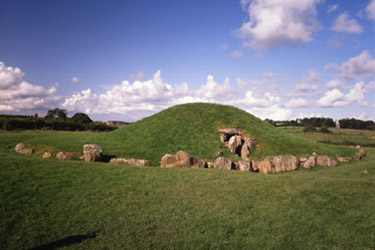
 Bryn Celli Ddu:
(Passage-Mound, Henge).
Bryn Celli Ddu:
(Passage-Mound, Henge).
One of
Wales most important megalithic sites.
This passage mound encompasses
a single white pillar inside and, along with a few other select sites in
Europe, is believed to have been constructed with the ability to
measure the year constructed into its design.
The passage is orientated
towards the rising summer-solstice sun.
(Plan
of Brynn Celli Ddu)
| Bryn
Celli Ddu: 'The Mound in a Dark Grove' |
Passage mound
with structural similarities to contemporary Irish and Scottish monuments.
The use of
the site appears to have changed over time. It started as a stone circle
surrounded by a bank and internal ditch. In the centre was a standing stone
covered in carvings, including spirals and zigzag patterns. A Passage grave
was built inside the ditch, with a North-east entrance. Finally, the whole
passage was covered with a cairn. Some time before the pillar and its
surrounding megaliths were erected, the stone was taken down and buried in
the middle of the original ring, outside the chamber. This stone has been
taken from its ancient setting to be stored in the National Museum of Wales
in Cardiff, and a replica casting has been erected in the socket of the
original stone. (16).
An exploration of the site
in 1928 discovered a pit at the centre of the henge in which a fire had been
set, over which a stone slab had been laid with a human ear-bone beneath.
On the ridge to the north of the site is another
tall standing stone.
The mound contains kerbstones,
which would have originally been covered up to similar to those at the
Boyne-Valley, Ireland.
The postholes discovered outside and
previously thought to be contemporary with the tomb (c 3,000 BC), have been
dated to over 6,000 years ago. (3).


A replica of the carved standing-stone
now stands behind the mound and the original is in the Museum of Wales. The
patterns on this stone have been compared to similar engravings found in the
Brittany region of France.
|
Article: BBC News (18 June 2006)
Bryn Celli Ddu Aligned to Sun.
An archaeologist
has discovered that the passage into a burial mound on Anglesey (Wales) was
built to catch the rising sun on the summer solstice. Steve Burrow said he
was 'elated' when the sun filtered in through trees as he sat in the Bryn
Celli Ddu chamber. He made the discovery as he researched a book about
burial tombs in Wales from 4,000-3,000 BCE. Carbon dating on the site has
also revealed it may contain the oldest building in Wales.
Mr Burrow, the curator of Neolithic archaeology at the National Museum
of Wales, said he had to visit the site twice before his discovery. On the
last day of his second visit he said he was 'absolutely elated' when the sun
filtered through nearby trees and entered the chamber along the five
metre-long entrance passage. "The emotion of seeing something that was put
there deliberately 5,000 years ago was amazing," he said. "I was the first
person to be recording the event so I was trying to record it with stills
and digital cameras as well as on a video camera, but I was jumping up and
down."
The site is owned by heritage body Cadw, which has part-funded a radio
carbon dating programme at the site. Testing has discovered that post holes
outside the entrance to the chamber are 3,000 years older than the tomb
itself. This could point to the site having the remains of the oldest
building in Wales, added Mr Burrow.
A video of the sun rising and entering the Bryn Celli Ddu chamber can
be viewed as part of an exhibition called Death in Wales 3,000-4,000 BCE, at
the National Museum of Wales in Cardiff until 24 September.
|
Astronomical Alignments.
The 'shadow gauge' on the pillar inside indicates where in the solar year you are
(from September to April).
(16)
At the winter solstice, the dagger
of sunlight would have reached the top of the pillar but for a concrete lintel
recently placed to secure the roof.
(16)
The pillar and stone edge are
also positioned to accurately measure the Venus cycle and the winter solstice.
(16)
The spring and autumn equinoxes
are marked by the sunlight moving onto the carved rock behind the pillar and
splitting to light up the sides of the chamber with its patterns and cup
markings.
(16)
On the summer solstice the runs
rays illuminate the chamber through the reflectivity of the quartz. For a few
minutes only it is directed to illuminate a small carved double spiral on stone
slab left of the entrance. It has been shown that this shape is achieved by
focusing and plotting the suns path over 366 days.
(16)
The passage was blocked except for a
small opening that didn't allow access. (light-box). Platforms of white quartz
pebbles, hearths and a structure surrounding the skeleton of an ox, found
outside the mound, suggest rituals.
(1)
Outside the passage a solitary standing
stone stands in line with the passage and the summer solstice alignment.
|
The Bryn Celli Ddu 'Lightbox': |
The alignment with the solstice sunrise links Bryn Celli Ddu to a
handful of other sites, including
Maes Howe and
Newgrange, both of which also point to the midwinter solstice. It has
also been suggested that a feature similar to the 'lightbox' at
Newgrange may be matched at Bryn Celli Ddu
(1).
Light-boxes are a megalithic construction feature
that have so far only been recorded at three (possibly four) sites
in the UK, with the two in Ireland (Newgrange and
Carrowkeel
- below)
both having the same design, and the other two on the
Orkneys (Maes Howe and
Crantit) in Scotland.
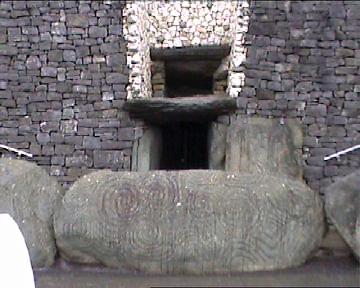
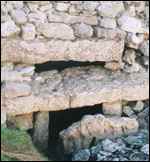
Newgrange (left), and
Carrowkeel (right)
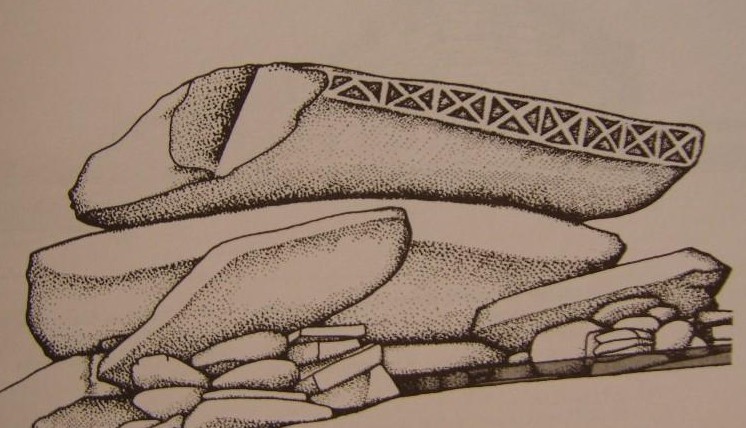
All of these sites have been shown to have been
deliberately constructed so
as to allow the rays of the sun (and/or moon) into the interior of
the passages for very specific time periods only. One of the stones
from the light-box at Newgrange (right) has a particular design on
it which can be found at two other passage mounds:
Gavr'inis in France, and
Four knocks in Ireland.
At
Maes Howe, the light of the
setting solstice sun was restricted by the closing of a 'portal stone', placed into the side of the passage. In this way, at the
right moment, the stone could be closed across the passage, and the
light would only pass over the top (as at Newgrange). The
same design feature is also present in the entrances of the three sub-chambers, each of
which also had a blocking-stone which closes most of the hole, but not all of
it. (These stones now lay on the floor in front of the holes).
This particular astronomical feature is similar to 'light-boxes'
found in other passage mounds in Ireland and Wales (Newgrange,
Carrowkeel). A similar
feature is believed to have been found on the Orkneys at the
recently destroyed/restored Crantit
Tomb.
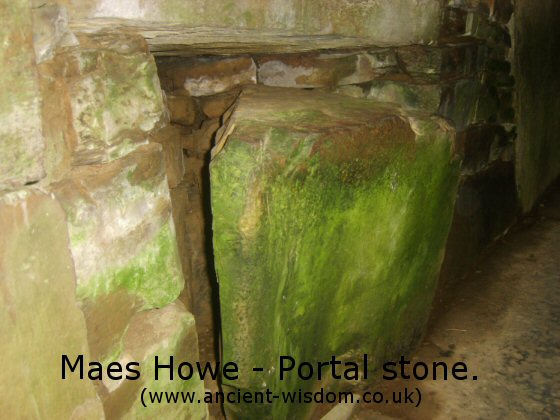
The Bryn Celli Ddu 'Light
Box'.The Bryn
Celli Ddu passage mound does not have a 'light-box' per se,
but it does have a sophisticated means of measuring the year
incorporated into its design, using the entry of light into the
passage at certain times, in a similar way as seen with light-boxes
elsewhere in UK.
At Bryn Celli Ddu, the passage-mound
was designed in such a way so as that the light of the sun at
relevant times of the year would penetrate the chamber and cause a
beam of light to be cast on a 'Declination Gauge' made by the tall,
cylindrical pillar placed at the back of the hexagonal chamber.

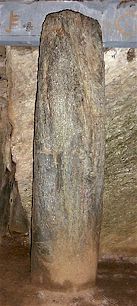
The changing altitude of the sun over
the year causes the light of the sun that reaches the inside of the
chamber to move up and down the pillar over the year. Notches have
been found which support this theory.
|
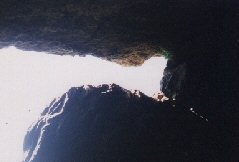
The positioning of the stones at the entrance and along the
passage restrict the light into a narrow beam which can be
seen to move up and down the pillar over the year. |
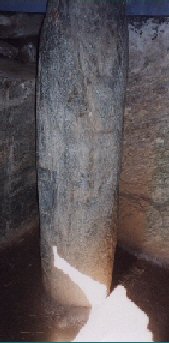
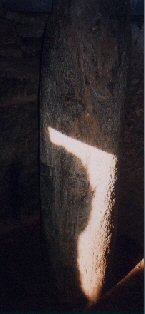 |
(More
about light-boxes)
|
Geodesy on the Prehistoric British
Landscape: It
has been observed that Bryn Celli Ddu is related to other important
geodetic sites through 'Pythagorean' geometry, as the following diagram
illustrates.

(English
Geodesy) |
(Other
Passage mounds)
(Other
Welsh Sites) |











